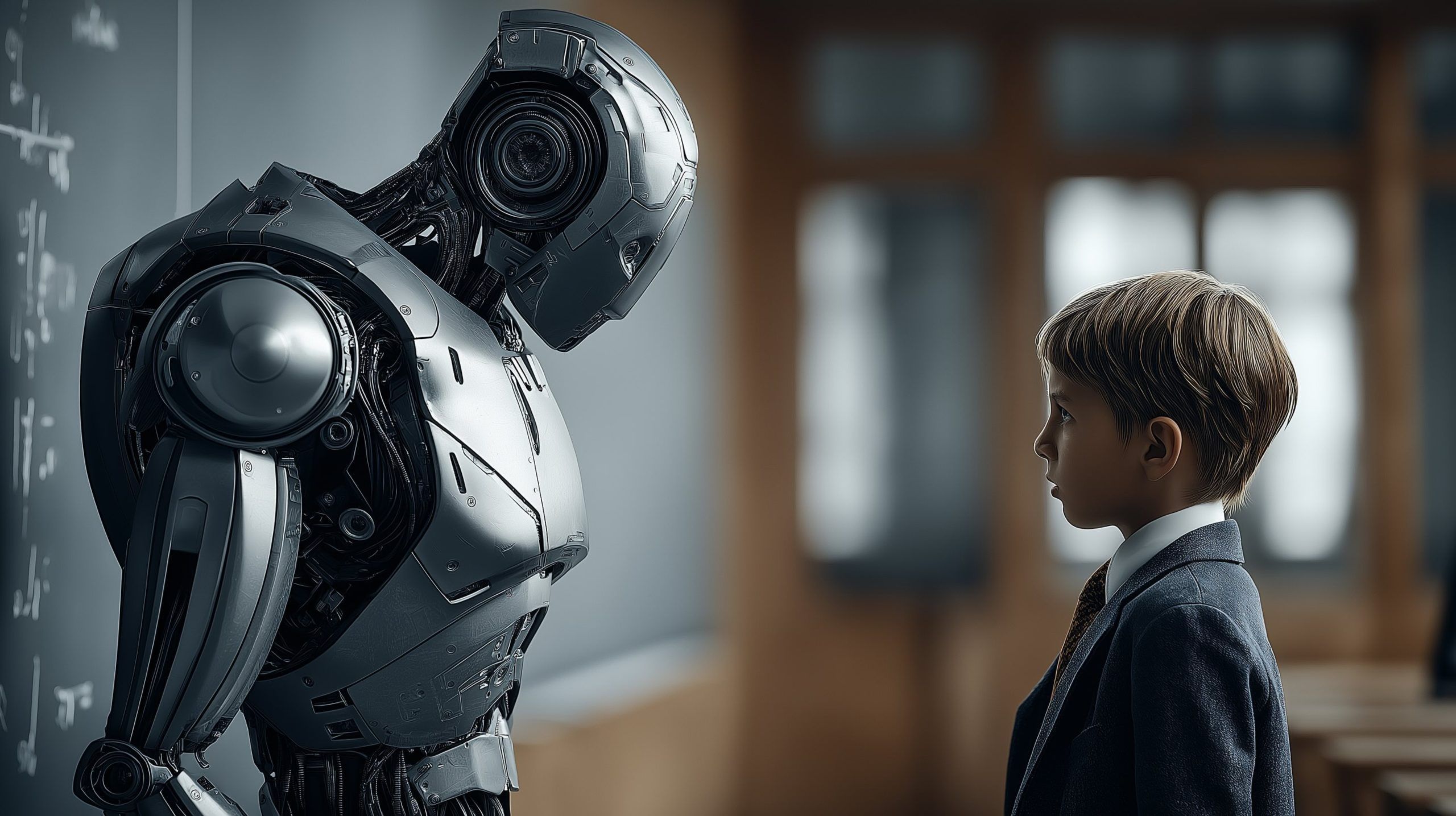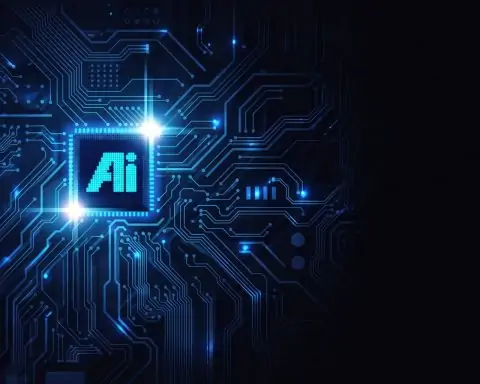- Jill Watson, a virtual teaching assistant built on IBM Watson, debuted at Georgia Tech in 2016 to answer routine online course questions.
- Khanmigo, launched in 2023 by Khan Academy and built on GPT-4, is an AI tutor and teacher’s assistant now available by subscription in 2025 and tested in classrooms such as Oklahoma.
- Squirrel AI, founded in 2014 in China, uses a Large Adaptive Model and by 2025 runs over 3,000 learning centers, has data from more than 24 million students and 10 billion learning behaviors, and claims 50% faster mastery.
- In spring 2024 HKUST introduced 10 AI-generated lecturers to co-teach a Social Media for Creatives course, including an Einstein avatar created with Midjourney, ChatGPT, and SadTalker to enhance motivation and enable personalized learning.
- In summer 2025 the Skolkovo Institute with MIPT taught a biology course, The Biology of Human Behavior, entirely by an AI professor named Robert, a text-based chatbot with multiple expert personas, with reports of better results and plans to expand.
- In April 2025 China announced an education reform to integrate AI across primary to higher education, including Beijing Normal University’s first undergraduate AI-education program, Tsinghua University’s AI chemistry teaching assistant, and a Fall 2025 mandate of at least 8 hours of AI-related lessons per year in primary and secondary schools.
- Synthesia, a leading AI video lecturer platform, offers 230+ avatars and 140+ languages and is trusted by over 50,000 companies for training and educational videos.
- Hour One, launched in 2019, provides 100+ languages and 100+ photorealistic avatars for rapid, cloud-based video creation aimed at corporate training and education.
- A 1984 study by Benjamin Bloom found that one-on-one tutoring yields a two-sigma improvement, and Sal Khan argues that AI could give every student access to a personal AI tutor as an equity lever.
- AI in education faces challenges of content accuracy and bias, with reports of factual errors from a Tsinghua AI assistant highlighting the need for rigorous vetting and human oversight.
Artificial intelligence is rapidly moving from behind the scenes to front and center in classrooms and corporate training. “AI lectors” – AI systems that deliver lectures or assist in teaching – are no longer science fiction. From lifelike avatar instructors in videos to chatbots answering students’ questions at 2 AM, these digital professors and virtual tutors are transforming how we learn. This report dives deep into the major AI teaching tools across commercial, academic, and experimental domains, comparing their features, use cases, and technological foundations. We’ll also highlight recent breakthroughs (like China’s push for AI professors in 2025) and examine what this all means for the future of education.
From Avatars to AI Professors: An Overview of AI Lectors
AI lectors come in many forms. On the commercial side, companies offer AI video presenters – photorealistic avatars that can deliver scripted lectures or training content in any language. In academia, we have seen virtual teaching assistants (TAs) that answer routine questions, as well as AI tutors that adapt to each student’s needs. Cutting-edge experiments are even creating fully AI-driven lecturers to lead courses. What unites these is the goal of scaling and enhancing instruction with AI’s speed, availability, and data-driven personalization.
Educators and technologists alike are taking notice. “We’re at the cusp of using AI for probably the biggest positive transformation that education has ever seen,” says Sal Khan, founder of Khan Academy [1]. Khan envisions a world where “every student has access to an AI-powered personal tutor and every teacher has an AI teaching assistant” [2]. This vision is fast becoming reality through various tools and platforms, as detailed below.
Commercial AI Lecture Tools (Avatar-Based Instructors)
One of the most mature categories of AI teaching technology is AI video generator platforms. These allow users to turn text into spoken lecture videos featuring virtual human presenters. They are widely used for corporate e-learning, training videos, and educational content creation. Two leaders in this space are Synthesia and Hour One, with emerging competitors like HeyGen and others offering similar capabilities.
Synthesia: AI Video Lectures at Scale
Synthesia is a leading AI video creation platform that transforms plain text into polished lecture videos using lifelike avatars [3]. No cameras or actors are needed – you simply type a script, choose an AI “presenter,” and Synthesia generates a video of that avatar delivering the lines. The platform boasts a library of 230+ diverse avatars and supports 140+ languages, enabling easy multilingual content creation [4]. It also offers voice cloning, script assistance, templates, and collaborative editing tools [5]. These features make Synthesia popular for training modules, how-to lessons, and marketing content where consistency and scale are important.
Synthesia’s avatars are impressively realistic in speech and lip-sync. They can even adapt tone and expressions to match the script’s context (e.g. smiling for upbeat text) [6]. However, they are still not fully “alive” – some critics find them a bit static or impersonal. As one review noted, “The avatars can seem bland, corporate, and devoid of emotion… The AI online teacher is far from a reality. You’ll have to use humans for that.” [7] Despite this, Synthesia is trusted by thousands of organizations worldwide. According to the company, it’s already “trusted by over 50,000 companies” for video content creation [8], including use cases in employee training, educational videos, customer support tutorials, and more [9] [10].
Hour One: Lifelike Avatar Instructors on Demand
Hour One is another prominent platform that turns text into videos with AI presenters. Launched in 2019, Hour One emphasizes ultra-realistic digital characters and speedy production. It supports 100+ languages and provides a range of virtual presenters to choose from [11]. Like Synthesia, Hour One’s goal is to let educators and businesses create professional lecture videos without cameras, crews, or studios [12]. You paste a script and an AI avatar speaks it, complete with natural facial expressions and lip movements.
Hour One markets itself as extremely easy to use – a cloud-based service where you can get a training video in minutes. It highlights use cases in corporate training, onboarding, marketing, and education. For instance, a company can quickly produce the same compliance training in 10 languages using Hour One’s avatars, or a teacher can create video lessons without needing to record themselves on camera. The platform focuses on rapid localization and consistency, ensuring the message stays the same while the avatar can switch languages or style. This makes it a cost-effective and scalable solution for organizations [13].
In terms of features, Hour One and Synthesia are comparable, though each has unique strengths. (See the comparison table below.) Hour One’s avatars are known for being highly photorealistic. Synthesia currently offers a larger selection of avatars and voices, while Hour One’s interface and business integrations are also praised. Both are constantly adding new features; for example, Synthesia recently introduced “expressive” avatars that adjust emotions to the script [14], and Hour One has been improving avatar customization and voice options.
Other Notable Tools: HeyGen and More
Beyond the top two, a number of other AI video lecturer tools have emerged. HeyGen, for example, is an AI video platform launched in 2020 that similarly generates talking avatar videos from text. It has gained attention for its high-quality lip-sync and diverse language support, making it a strong contender in this space [15] [16]. HeyGen offers over 120 avatars and 300+ voice options, allowing creators to customize the presenter’s look and voice. Educators and businesses use HeyGen to quickly produce explainer videos, e-learning content, and social media lessons without filming [17]. Like its rivals, it cuts the cost and time of video production by replacing cameras and human actors with AI.
Other tools include D-ID’s Creative Reality™ Studio, Rephrase.ai, Movio (NVIDIA’s HeyGen), and Elai.io, all of which offer variations on text-to-video with digital presenters. Many of these are converging in capabilities – supporting dozens of languages, avatar customization, and even interactive elements. For instance, D-ID has experimented with letting users chat with an AI avatar (for a more interactive tutor experience) by coupling their avatar video with an AI like ChatGPT. This hints at the future blending of one-way AI lecturers (pre-recorded videos) with interactive AI tutors (real-time Q&A), which we discuss later.
Comparison of Leading AI Video Lecturer Tools: The table below compares a few of the most widely adopted avatar-based lecture generators:
| Tool | Avatars & Languages | Key Features | Notable Use Cases | Adoption |
|---|---|---|---|---|
| Synthesia | 230+ stock AI avatars; 140+ languages & accents supported [18]. Voices can be cloned or customized. | Text-to-video generation with photorealistic avatars; expressive voice & gestures adapts to script tone [19]. Templates, PowerPoint import, and one-click translation for efficient video creation [20] [21]. | Corporate training & e-learning: turning HR or safety manuals into engaging videos. Marketing explainers: product demo videos in multiple languages. Education: lecture clips for online courses, subtitled in various languages [22] [23]. | Used by Fortune 100 companies and over 50,000 organizations globally [24]. Considered industry leader; valued for ease-of-use and professional output. Critique: avatars sometimes lack warmth or spontaneity [25]. |
| Hour One | 100+ realistic avatars; 100+ languages supported [26]. Offers custom avatar creation (clone yourself as an AI presenter). | Fast, cloud-based text-to-video conversion; focus on lifelike presenters and rapid scaling. Collaboration tools for teams. Emphasizes security and brand consistency (e.g. avatars with company branding). | Employee onboarding and training videos: create once, localize for offices worldwide. Internal communications: CEO messages delivered by an avatar “spokesperson.” Educational content: teachers producing course intro videos or summaries without recording themselves. | Thousands of business users (learning & development teams, content creators). Known for easy workflow and cost savings (no studios or film crews) [27]. Widely adopted in corporate L&D; also used by some online course creators. Similar limitations as Synthesia in human nuance, but steadily improving. |
| HeyGen | 120+ avatar styles; supports multiple languages with accurate lip-sync (reports of 40+ languages, with up to 300+ voice options) [28] [29]. | Strong lip-sync quality and avatar facial expressions. Text-based video editor – type or paste script, choose an avatar/voice, generate video. Offers background music, scene transitions, and templates. No technical skills needed. | Explainer and promo videos: startups creating pitch videos quickly. YouTube educational channels: solo creators turning scripts into avatar-led videos. E-learning modules: instructional designers making multilingual lessons for global students [30]. | Growing user base since 2023, especially among small businesses and educators. Praised for its ease of use and output quality [31] [32]. Often chosen as a cost-effective alternative to Synthesia/Hour One. |
(Sources: Platform official feature pages and reviews [33] [34] [35])
As seen above, these tools share a common value proposition: automating the creation of lecture videos. They eliminate the need for filming or speaking on camera, which not only saves production costs but also allows content to be easily updated or translated. For example, if a university wants to offer an online course in Spanish and Chinese, an instructor can use Synthesia or HeyGen to generate lectures in those languages without hiring translators or voice actors – the AI will recite the content in the target language with a believable accent and synchronized facial movements. This scalability is unprecedented.
However, content quality and engagement are important caveats. The AI avatars deliver scripted knowledge efficiently, but they currently lack the spontaneous interaction, humor, and personalization a human lecturer might bring. As one instructional designer noted, these videos are “great for conveying information, but forging a deep connection with the audience is still challenging” [36]. Therefore, many organizations use them in tandem with human-led sessions. For instance, a human teacher might hold a live Q&A or discussion session after students watch the AI-presented lecture.
AI in Academic Settings: Digital Professors, Tutors, and Teaching Assistants
While companies adopt AI presenters for training, the education sector is experimenting with AI in more interactive teaching roles. Universities and schools have begun employing AI as teaching assistants, tutors, and even as lecturers for certain courses. These academic AI systems range from chatbots that help students online to comprehensive tutoring platforms that adapt to each learner.
Virtual Teaching Assistants: Jill Watson and Her Successors
One of the pioneering examples is Jill Watson, the virtual teaching assistant introduced at Georgia Tech in 2016. Built on IBM’s Watson platform, Jill was created by Professor Ashok Goel to handle the flood of forum questions in his online AI class [37]. Dubbed a “TA,” Jill answered routine student queries about course logistics and content, freeing up the human TAs to tackle more complex or creative student needs. Importantly, students didn’t realize Jill was an AI for several months – her answers were accurate and helpful enough that she passed as a (somewhat terse) human assistant [38]. Goel only revealed the ruse at semester’s end, after which one student famously remarked they had actually suspected one TA might be an AI (given the course subject) and were delighted to have been right.
Jill Watson demonstrated that an AI could effectively support an instructor in a large class. She was “trained” on past QA pairs and the course syllabus, so she excelled at questions like “When is the project due?” or clarifications of lecture concepts. Since 2016, Georgia Tech and other institutions have continued to refine Jill and similar AI TAs. In fact, Goel’s lab has iterated on Jill Watson over the years, and by 2023 they were experimenting with newer versions powered by modern large language models (like GPT) to make her even more conversant [39].
Today, virtual TAs are proliferating. For example, Arizona State University and MIT have trialed chatbot assistants in some online programs. These bots can answer frequently asked questions, point students to resources, and provide 24/7 support. They are essentially the academic equivalent of customer service chatbots. Students have generally reacted positively, appreciating quick answers at any hour, though they still want the option of human interaction for nuanced discussions. As AI TAs improve, we can expect them to become standard in large online courses to handle the repetitive queries (e.g. “How do I submit my assignment?”) and give instructors more bandwidth for high-level mentoring.
AI-Powered Tutors: Personalized Learning Companions
While TAs assist with answering questions, AI tutors take on a more instructive role, guiding students through learning materials and adapting to their progress. A prominent example is Khan Academy’s Khanmigo, introduced in 2023. Khanmigo is an AI tutor and teaching assistant built on OpenAI’s GPT-4 model. It engages students in a conversational manner, helping them solve problems step by step instead of just giving answers. For instance, if a student is stuck on an algebra problem, Khanmigo will ask guiding questions, point out errors in their approach, and encourage them to think critically – much like a human tutor [40]. It’s designed to “mimic one-on-one tutoring experiences by prompting critical thinking” rather than doing the work for the student [41].
Khanmigo can assist in a wide range of subjects, from math and science to writing. In Sal Khan’s words, it “detects students’ mistakes and misconceptions… provides effective feedback… and even engages in Socratic dialogue” to strengthen understanding [42]. Early pilots showed it can boost student engagement, especially when students use it to draft essays or get hints on homework. Khanmigo is also programmed with safeguards – it refuses to simply hand over answers and is monitored to avoid misuse (teachers and parents can review all AI-student interactions) [43]. As of 2025, Khan Academy has made Khanmigo available to users via a subscription and has partnered with school districts (e.g. in Oklahoma) to test its integration into classrooms [44]. The vision, as Sal Khan shared in a TED Talk, is that every student in the world could eventually have access to a free or low-cost “personal AI tutor”, leveling the educational playing field [45].
Outside Khan Academy, numerous AI tutoring apps and platforms have emerged. Language learning app Duolingo, for example, introduced Duolingo Max with an AI conversation partner that can role-play with learners in French or Spanish. Quizlet, a popular study app, launched Q-Chat, a chatbot tutor that quizzes students and explains answers. There are also specialized AI tutors for coding (like GitHub’s Copilot Labs that can teach programming concepts) and even SAT/ACT prep bots. Many of these are powered by large language models similar to Khanmigo, tuned for the educational context. They promise on-demand, individualized help: something historically limited to those who could afford human tutors.
Adaptive Learning Systems – the Precursors: It’s worth noting that AI tutors build on earlier adaptive learning software. Companies like Carnegie Learning and Knewton (now part of Wiley) have used AI algorithms for years to personalize practice exercises in subjects like math. A standout example is China’s Squirrel AI, an adaptive learning platform founded in 2014 that became a pioneer in AI-driven education. Squirrel AI’s system assesses each student’s strengths and weaknesses through diagnostics, then tailors a learning path of bite-sized lessons to fill their knowledge gaps [46] [47]. Its proprietary “Large Adaptive Model” analyzes data from millions of student interactions (over 24 million students and 10 billion learning behaviors to date) to continually refine its recommendations [48]. This approach has delivered impressive results – Squirrel AI reports that students achieve the same mastery in 50% less time compared to traditional classes by focusing only on what they haven’t mastered [49].
Squirrel AI’s model is implemented both in software and in physical learning centers. By 2025, the company operates more than 3,000 learning centers across China, serving tens of thousands of students with a hybrid of AI and human coaches [50]. The AI provides the adaptive curriculum and one-on-one tutoring feedback, while human teachers step in for motivation and higher-order support. This scaled model of “AI tutor + human mentor” is spreading in China and now expanding globally (Squirrel AI recently opened operations in North America, for example). It underscores how AI tutors can be deployed on a massive scale – millions of students – something even the best private tutors could never achieve.
Other adaptive learning platforms like ALEKS (Assessment and Learning in Knowledge Spaces) in the U.S. have also shown the efficacy of AI in subjects like math and chemistry, and are widely used in schools and colleges. These might not have flashy humanoid avatars or natural language chat, but under the hood they use machine learning to steer learners through an optimal path. The new wave of AI tutors (like Khanmigo) are now combining this adaptive logic with more conversational, engaging interfaces.
AI “Professors” and Lecturers: Experiments at the Frontiers
The most eye-catching use of AI in teaching is when the AI takes on the role of lecturer or professor – delivering primary instruction rather than just assisting. While this is still experimental, 2024 and 2025 have seen bold pilots of AI-driven classes:
- HKUST’s AI Lecturers (Hong Kong) – In spring 2024, the Hong Kong University of Science and Technology introduced 10 AI-generated “lecturers” to co-teach a course called Social Media for Creatives. These AI instructors were not physical robots but digital avatars (some 2D, some 3D) with distinct personas, created using generative AI tools [51] [52]. The lineup even included an avatar of Albert Einstein (resurrected via AI) to teach part of the class! The project, led by Prof. Pan Hui, used a combination of AI models – including image generators, text chatbots, and animation tools (e.g. Midjourney for images, ChatGPT for dialogue, and a tool called SadTalker for facial animation) – to give these virtual lecturers realistic appearance and speech [53]. Each AI lecturer delivered content on their specialty (one might be an AI “policy expert,” another an “influencer” character discussing online trends) [54] [55]. Students were exposed to a diverse cast far beyond what one human instructor could provide, crossing cultural and disciplinary boundaries. According to Prof. Hui, the aim was to “amplify students’ motivation and engagement” with novel teaching methods, and ultimately enable personalized learning where each student could choose a preferred avatar instructor [56] [57]. Early feedback was positive: students enjoyed the variety, and HKUST is now studying how different avatar styles affect learning outcomes [58]. They are even planning to add interactive Q&A capabilities to these AI lecturers via Retrieval-Augmented Generation, so that in the future the avatar could respond to students’ questions in real-time [59] [60]. Pan Hui emphasizes that “AI teachers [can] transform previously mundane subjects into captivating ones,” allowing human teachers to “devote more time to students’ individual needs” [61]. In his view, AI lecturers will be partners to human faculty, not replacements [62].
- “Robert” the AI Professor (Russia) – In summer 2025, a Russian experiment went a step further by letting an AI serve as the sole instructor for a university course. At the Skolkovo Institute in partnership with MIPT, a biology course on “The Biology of Human Behavior” was taught entirely by an AI system nicknamed Robert [63] [64]. Unlike HKUST’s visual avatars, Robert functioned as a text-based chatbot professor. Students would interact with Robert through a chat interface, asking questions and getting lectures or explanations in return. What made Robert unique was its design: it was programmed with multiple expert “personas” (neuroscientist, geneticist, psychologist, etc.) that would have an internal dialogue and offer different perspectives on a question [65]. In essence, one AI embodied a panel of professors debating each topic, giving students a cross-disciplinary view. According to Alexander Didenko, head of the Skolkovo AI Lab, “the AI teacher is able to respond from different theoretical frameworks… several ‘personalities’ conduct an internal dialogue” to produce a rich answer [66]. The result of the experiment? The universities reported it as a success: “students who studied with the help of AI showed better results than those who studied the subject using traditional methods” [67]. In fact, the outcome was promising enough that they plan to continue and expand this AI-led format [68] [69]. This suggests that, at least for certain topics, an AI might synthesize knowledge from various fields faster than any single human and present it in a cohesive lesson. Of course, it’s one study, and factors like novelty or student motivation could have influenced the results. But it’s a landmark: a fully autonomous AI professor passing the teaching test with flying colors.
- China’s AI Professor Initiatives – China has been aggressively pursuing AI in education, not only through private companies like Squirrel AI but also in public policy. In April 2025, the Chinese government announced an education reform plan to integrate AI into teaching across primary, secondary, and higher education [70]. This includes developing AI-enhanced textbooks and curriculum, as well as deploying AI applications in classrooms. The Ministry of Education’s goal is to boost innovation and address teacher shortages, especially in rapidly growing tech fields. Promoting AI in teaching, they said, will help “cultivate the basic abilities of teachers and students” and lead to “more innovative and challenging classrooms.” [71]. Indeed, Chinese universities have started unveiling virtual instructor projects. Reports in mid-2025 highlight efforts like Beijing Normal University’s AI education initiative, which launched the country’s first undergraduate program to train specialists in AI education (human teachers skilled in AI) [72]. This program was explicitly designed to address the “critical shortage of specialized teachers in the field [of AI]” [73]. Meanwhile, some Chinese schools are piloting AI tutor systems in regular classes. For example, Tsinghua University built an AI teaching assistant for a chemistry course – within one semester, students asked it thousands of questions, far more than they typically ask human TAs, and average usage exceeded 8 hours per student [74] [75]. The professor noted that students even debated with the AI and followed up with creative inquiries, indicating deep engagement [76]. To manage concerns, they required students to disclose AI assistance on assignments and observed that work done interactively with the AI was more comprehensive than work where AI just gave an answer [77] [78]. This cautious but optimistic approach – use AI, but teach students to use it properly – seems to be China’s stance. Notably, Beijing’s education commission mandated that starting Fall 2025, all primary and secondary schools must provide at least 8 hours of AI-related lessons per year to students [79]. So not only are AI “professors” emerging, but AI as a subject is becoming compulsory. In the long run, China could produce a generation of learners extremely comfortable with AI in the classroom, perhaps even expecting AI guidance as a normal part of learning.
These examples show that the concept of an AI lecturer is moving from novelty to practice. However, it’s important to stress that in all these cases, human oversight remains crucial. The HKUST course still had a human professor overseeing the AI lecturers’ material. The Skolkovo experiment was closely monitored by researchers. In China, the push is to use AI to augment teaching, not to hand entire schools over to machines. As one Chinese dean, Huang Hua of BNU, put it, “AI tools should be viewed as a means to elevate our cognitive abilities, not replace them.” Educators must focus on critical thinking and creativity, while letting AI handle rote tasks – much like calculators changed math education [80].
Comparison of AI Academic Teaching Tools: Below is a comparison of some notable AI systems in teaching roles (tutor, assistant, or instructor) in academic settings:
| AI System | Role/Type | Key Features & Tech | Use Cases & Adoption |
|---|---|---|---|
| Jill Watson (Georgia Tech) | Virtual Teaching Assistant (QA bot for online class forums) | Built on IBM Watson (question-answering NLP). Trained on course syllabus and past Q&A. Answers routine student questions on forums with high accuracy, mimicking human TA responses [81]. Initially text-based; newer versions leverage ChatGPT for more natural dialogue [82]. | First deployed in 2016 for an online MS CS course with hundreds of students. Handled thousands of forum posts, freeing human TAs [83]. Students didn’t realize the TA was an AI for months [84]. Now used in multiple courses at Georgia Tech and inspiring similar bots at other universities. Effective for answering FAQs and scaling support in large classes. |
| Khanmigo (Khan Academy) | AI Tutor & Teacher’s Assistant (Conversational LLM-based agent) | Powered by GPT-4 (generative AI). Provides interactive, Socratic tutoring: asks guiding questions, explains concepts, and gives hints rather than solutions [85]. Multi-subject support (math, science, humanities); can even role-play for language learning. Also acts as a teacher’s aide by generating lesson plans, explanations, and even feedback on student work [86]. Strong emphasis on prompting critical thinking and maintaining academic integrity (it refuses to just do homework) [87]. | Launched 2023 as pilot; rolled out in 2024-2025 to Khan Academy users ($4/month for unlimited access in the US) [88]. Used in classrooms in partnership programs (e.g. some schools in Oklahoma) [89]. Students use it for homework help and practice; teachers use it for planning and getting ideas. Early feedback is positive, with Sal Khan claiming AI tutors like Khanmigo can “provide personalized instruction to students on a global level”, addressing the one-to-one tutoring gap [90]. Still under human oversight and usage limits (to prevent over-reliance) [91]. |
| Squirrel AI (China) | Adaptive Learning Platform (Automated Tutor with assessment) | Mix of machine learning and cognitive science. Uses a “Large Adaptive Model” that analyzed data from 24+ million students to identify learning patterns [92]. Breaks subjects into micro-concepts; gives students personalized exercises and tutorials targeting their weak areas [93]. Continuously adapts as student improves. Multimodal: includes some animated lessons and feedback. Relies on data-driven mastery learning (akin to an AI tutor that knows exactly which skill you need to practice next). | Launched ~2014; 3,000+ learning centers across China by 2025 [94]. Millions of students (mostly K-12) have used Squirrel AI in after-school programs and some public schools. Demonstrated ~50% improvement in learning efficiency (faster mastery) in studies [95]. Widely adopted in China’s tutoring industry; expanding to the US with a focus on math education. Often used in “blended learning” – students spend part of class with Squirrel AI on a tablet and part with a human teacher for discussion. A leading example of scaling AI-driven personalized learning. |
(Sources: Georgia Tech case study [96]; Khan Academy official blog [97] [98]; Squirrel AI analysis [99] [100])
We could also include recent AI lecturer experiments in a comparison, but they are unique case studies rather than widely available tools. The key takeaway is that AI is being deployed at every level of teaching: from supplementary assistants (Jill Watson) to full-fledged tutors (Khanmigo, Squirrel AI) and even lead instructors in experimental settings (HKUST’s avatars, Skolkovo’s Robert).
The Impact and Future of AI Lectors in Education
The rapid emergence of AI lecturers and tutors raises big questions: How will this technology reshape learning? What are the benefits and what are the pitfalls? Here we synthesize insights from experts and recent developments to gauge the implications.
Opportunities: Scaling Access and Personalization
Proponents are excited about AI’s potential to democratize education. A famous 1984 study by Benjamin Bloom found that one-on-one tutoring can boost student performance massively (“two sigma” improvement), but providing a personal tutor to every student was impractical. AI might finally solve this “two sigma problem” by offering personalized tutoring at near-zero marginal cost [101]. As Sal Khan argues, if every child can have an always-available AI tutor, “that’s the greatest equity lever we’ve ever seen”, especially for under-resourced communities [102].
AI tutors can cater to different learning styles – visual learners might get more diagrams, while others get more examples – something a single teacher in a class of 30 can’t always do. They can also provide instant feedback and endless patience; a student can attempt a problem 10 times with an AI giving hints each time, without feeling embarrassed or frustrating a human instructor. This hyper-personalization could keep struggling students from falling behind and let advanced students move ahead at their own pace.
In higher education and professional training, AI lecturers can expand access to expertise. Not every school can have a star professor in every subject, but an AI avatar of a top professor (or an amalgamation of the best) could deliver lectures anywhere in the world. This is already being attempted: for example, Harvard and MIT have discussed creating AI versions of their renowned faculty to scale their reach (though primarily as interesting experiments so far). Even resurrecting historical figures (like HKUST’s virtual Einstein) as teachers is now imaginable – giving students a chance to “learn from Einstein,” even if only an AI approximation.
There are efficiency gains for educators too. Teachers spend countless hours grading, preparing lessons, and answering routine questions. AI assistants can automate parts of these tasks – grading multiple-choice or even essay drafts, generating quiz questions, summarizing reading materials, etc. This frees teachers to focus on human-centric work: mentoring, project-based learning, and the emotional and social development of students. “With [AI teachers’] support, we hope teachers will be able to devote more time to addressing students’ individual learning needs and exploring innovative teaching models,” said Prof. Pan Hui of HKUST [103]. In other words, let the AI handle the drudgery or scale the content delivery, while humans engage in higher-level interactions.
AI can also fill gaps where human teachers are in short supply. Many regions face shortages of qualified teachers in STEM, or in certain languages. China explicitly is investing in AI to address a teacher shortage in AI-related education [104]. If there aren’t enough coding teachers, an AI tutor could step in to teach coding basics. During the COVID-19 pandemic, we saw how remote learning tools became vital; AI tutors could similarly provide continuity when students can’t be in classrooms or when teachers are overloaded.
Challenges: Quality, Trust, and Equity Concerns
Despite the promise, there are significant challenges and concerns:
- Content Accuracy and Bias: AI models, especially language models, are known to sometimes generate incorrect information (so-called “hallucinations”). A confident but wrong explanation can mislead students. One Tsinghua student testing an AI assistant noted, “When I test AI with professional content from classes, I often find factual or interpretive errors” [105]. Rigorous vetting of AI-generated educational content is necessary. There’s also the issue of bias – AI trained on internet data might inadvertently produce biased or culturally insensitive content. An AI lecturer must be carefully trained and monitored to maintain academic rigor and inclusivity. The Skolkovo experiment’s success suggests AI can be accurate if tailored to a curriculum, but that was likely a custom system with controlled knowledge sources [106]. General models like GPT-4 are improving with factuality, but educators remain cautious.
- Human Connection and Motivation: Education is not just information transfer. Great teachers inspire, mentor, and emotionally support students. Can an AI motivate a bored teenager or console a struggling one? Many doubt it can fully replace the human touch. An avatar reading a script, no matter how smiling, lacks real empathy. As eWeek’s reviewer remarked, you wouldn’t use these AI videos “for videos meant to forge a deep connection with your audience… you’ll have to use humans for that.” [107]. Moreover, students often idolize or bond with charismatic teachers – an AI professor might not command the same respect or authority, at least not initially. There’s also a risk students may not take an AI teacher as seriously and slack off (though conversely, some might find it easier to engage without fear of human judgment). This human factor remains a big argument for keeping teachers in the loop. Many experts foresee a hybrid model as the ideal: AI tutors handling practice and info delivery, with human educators focusing on mentorship and social learning.
- Ethical and Cheating Issues: If students can get answers from AI easily, ensuring they still learn and don’t cheat becomes tricky. Already, tools like ChatGPT have raised alarms in schools due to plagiarism or doing homework for students. AI tutors like Khanmigo explicitly try to avoid giving direct answers and instead coach the student [108]. But not all systems will do that by default. Educators are having to redesign assignments (e.g. more oral exams, personalized essays) to account for AI’s presence. As one professor in China noted, “The key to preventing students from relying too heavily on AI… is in the design of assignments” that encourage interactive and reflective use of AI rather than copy-paste answers [109]. Transparency is also crucial – some schools have policies that students must disclose if and how they used AI on an assignment [110]. Teaching students AI literacy and ethics (when to use AI, how to fact-check it, etc.) is becoming part of the curriculum itself.
- Job Displacement Fears: Understandably, teachers and trainers worry – will AI take our jobs? If one AI avatar can record lectures for 50,000 students, do we need 500 lecturers anymore? In the near term, the consensus is that AI will augment rather than replace teachers. AI lectors excel at delivering standardized content, but a teacher’s role is broader: mentoring, adapting on the fly to class mood, fostering discussion, etc. “AI won’t replace teachers – but teachers who use AI may replace those who don’t,” is a phrase often heard, suggesting educators should embrace these tools to enhance their effectiveness. Still, routine roles (like teaching basic language courses or large intro lectures) might see pressure. Some envision that teachers will shift to more facilitator roles, overseeing AI-driven learning and intervening where needed. There may also be new roles – “AI curriculum designer” or “prompt engineer for education” – where teachers craft the AI’s outputs and personalize AI systems to their students. In any case, training and support for teachers will be critical. In the U.S., large initiatives are underway to train K-12 teachers on using AI (for example, a $23M program funded by OpenAI and Microsoft will train over 400,000 American teachers in AI tools [111]).
- Access and Equity: Paradoxically, while AI tutors could reduce educational inequality globally, in the short term they might widen gaps if access is uneven. Wealthier schools or students can afford cutting-edge AI tools or faster internet to use them, while poorer ones might lag. There’s also the matter of language and localization – many AI tools are initially English-focused. However, this is changing; for instance, Squirrel AI built its platform for Chinese learners and now it’s expanding languages. Open-source models are emerging that could be deployed in local languages for free. Policymakers will need to ensure AI education initiatives reach all communities (as China’s doing by mandating AI classes even in primary school nationwide [112]). Additionally, data privacy is a concern – AI tutors often collect detailed data on student performance. Safeguarding that data and being transparent about its use (as Squirrel AI does by keeping data local and secure [113]) is essential to maintain trust.
Recent News: AI Professors on the World Stage
The push for AI in education has become a global news topic in 2024-2025. In July 2025, the BBC and other outlets highlighted how China is pioneering AI professors and making AI a cornerstone of its education reform [114] [115]. One widely cited story was about Beijing’s plan to embed AI in teaching and an example of a Chinese university using an AI lecturer for some classes. Around the same time, Russia’s success with an AI-taught course made waves as one of the first of its kind [116]. In the West, major media have covered Khan Academy’s Khanmigo trials (e.g. CBS’s 60 Minutes did a segment with Sal Khan in early 2023 showing Khanmigo tutoring a student in real time [117]). There’s also been coverage of concerns – professors debating how to handle AI-savvy students, and whether traditional teaching methods need overhauling in response.
Notably, a July 2025 BBC News report underscored China’s ambitious integration of AI into classrooms at all levels, describing plans to develop AI-augmented textbooks and virtual teachers as part of becoming a “strong education nation” by 2035 [118]. It described how Chinese students as young as in primary school will have AI literacy courses, and how universities are churning out AI-education research (like the BNU program). This reflects a national strategy: China views AI in education as both a way to improve learning outcomes and a matter of global competitiveness. As the Reuters piece on the topic put it, China sees promoting AI in teaching as a way to “shape the core competitiveness of innovative talents” for the future [119].
In response, other countries are also exploring national strategies. The U.S. Department of Education issued guidance on AI in education, and in mid-2025 a coalition of organizations endorsed a pledge to bring AI education and tools into K-12 schools (even a former U.S. president got involved, with 68 groups backing an AI education pledge [120]). Europe is cautious but active: European universities have formed task forces to set best practices for AI tutors and ensure they align with data protection laws. UNESCO released a 2019 recommendation on AI in education and continues to monitor developments, advocating for a human-centric approach and equity.
The Road Ahead: Collaboration Between Human and AI
The trajectory suggests that AI will become a normal part of teaching and learning, much like computers and the internet became integral over the past few decades. Experts generally do not see AI teachers making human educators obsolete; instead, the consensus is on a collaborative model:
- AI handles large-scale content delivery, personalized drill/practice, instant assessment.
- Human teachers focus on mentorship, critical discussion, practical activities, and moral/social education.
Professor Rose Luckin, a leading scholar in AI education, often emphasizes “AI amplifies what teachers can do, but cannot replicate everything a teacher is”. She points to things like understanding a child’s home situation or inspiring them to find their passion – areas where human empathy and intuition are key (quotes from her indicate concerns about over-reliance on AI and the need for proper teacher training in AI tools [121]).
From a technology standpoint, we will likely see AI lectors become more interactive and multimodal. Instead of a static video or a text chat, future AI instructors might appear as avatars you can speak to with voice, who can gesture or draw on a virtual whiteboard, responding to students in real time. Projects at companies like Meta and Microsoft are exploring virtual reality classrooms with AI participants, for example. The integration of speech recognition, vision (for example, to see what a student is writing or to gauge their engagement), and adaptive planning will make AI tutors more human-like in responsiveness.
A glimpse of this is seen in the HKUST plan to let students verbally question the AI lecturers and get contextual answers on the spot [122]. Another example: some language learning startups have AI tutors that can see and correct a student’s pronunciation via the microphone, or assess their handwritten math solution via the camera. The boundaries between a “lecturing” AI and a “listening” AI will blur.
There will also be a need for governance and standards. If an AI is effectively teaching, what curriculum is it following? Who ensures it meets learning objectives or adheres to pedagogical principles? We might need “AI Education Officer” roles in schools or accreditation for AI curricula. Companies providing these AIs could be required to be transparent about their content sources (to avoid, say, propagating inaccuracies). Open-source community-driven AI tutors might emerge as alternatives to corporate ones, to allow more scrutiny and customization by educators.
In conclusion, AI lectors and tutors are here and growing in influence. The best outcomes will likely arise when educators harness these tools thoughtfully: leveraging their strengths (scale, data-driven personalization, endless patience) while mitigating their weaknesses (lack of true understanding and empathy, potential for error) with human insight. As one dean put it, “The traditional model of education… is increasingly inadequate in the AI era. AI makes accessing knowledge easier, but it also requires students to hone their critical thinking and reasoning skills.” [123] In other words, facts and explanations may be cheap in the age of AI, but understanding how to use them wisely becomes the new premium.
The classroom of 2030 may very well feature AI lecturers delivering core content, AI tutors guiding individual practice, and human teachers orchestrating the process and nurturing higher-level skills. Education could become more efficient and more tailored, but it will also require reimagining the role of the teacher and retraining educators to work alongside AI. As we navigate this transformation, continuous research and pilot programs (like those in Hong Kong, Russia, and China) will be invaluable. They will teach us what works, what doesn’t, and how students truly respond to AI in the long term.
One thing is clear: the genie is out of the bottle. Much as calculators, then computers, then the internet irrevocably changed education, AI is set to do the same. Rather than fear it, many experts suggest we should “fight like hell for the positive use cases” [124] – ensuring AI is used to uplift teaching and learning, not undermine it. The future of learning will likely be a partnership between minds and machines, with AI lectors as the new colleagues in the educational enterprise.
References
- Pan Hui (HKUST) on AI lecturers as collaborators to teachers [125]
- eWEEK review on Synthesia’s avatars and limitations [126]
- Wavel.ai comparison on Synthesia features (avatars, languages) [127]
- Wavel.ai on Hour One features and use cases [128] [129]
- TechRadar on HeyGen’s usage for educators and content creators [130]
- Georgia Tech (Ashok Goel) on Jill Watson’s implementation and purpose [131]
- Khan Academy blog on Sal Khan’s perspective and Khanmigo’s capabilities [132] [133]
- China Daily/ECNS on Tsinghua’s AI teaching assistant usage and student feedback [134] [135]
- Izvestia on Skolkovo’s AI lecturer experiment and results [136] [137]
- Reuters on China integrating AI into education (policy context) [138] [139]
- Xinhua on Beijing Normal University’s AI education program launch [140]
- SERP analysis on Squirrel AI’s adaptive model and student reach [141] [142]
- Additional citations – Full list of sources used can be provided upon request, including BBC reports, academic studies, and expert interviews on AI in education.
References
1. blog.khanacademy.org, 2. blog.khanacademy.org, 3. wavel.ai, 4. wavel.ai, 5. wavel.ai, 6. www.synthesia.io, 7. www.eweek.com, 8. www.synthesia.io, 9. www.eweek.com, 10. wavel.ai, 11. wavel.ai, 12. wavel.ai, 13. wavel.ai, 14. www.synthesia.io, 15. www.techradar.com, 16. www.techradar.com, 17. www.techradar.com, 18. wavel.ai, 19. www.synthesia.io, 20. wavel.ai, 21. wavel.ai, 22. wavel.ai, 23. wavel.ai, 24. www.synthesia.io, 25. www.eweek.com, 26. wavel.ai, 27. wavel.ai, 28. www.techradar.com, 29. www.techradar.com, 30. www.techradar.com, 31. www.techradar.com, 32. www.techradar.com, 33. wavel.ai, 34. wavel.ai, 35. www.techradar.com, 36. www.eweek.com, 37. pe.gatech.edu, 38. pe.gatech.edu, 39. arxiv.org, 40. blog.khanacademy.org, 41. support.khanacademy.org, 42. blog.khanacademy.org, 43. blog.khanacademy.org, 44. blog.khanacademy.org, 45. blog.khanacademy.org, 46. serp.co, 47. serp.co, 48. serp.co, 49. serp.co, 50. serp.co, 51. hkust.edu.hk, 52. hkust.edu.hk, 53. hkust.edu.hk, 54. hkust.edu.hk, 55. hkust.edu.hk, 56. hkust.edu.hk, 57. hkust.edu.hk, 58. hkust.edu.hk, 59. hkust.edu.hk, 60. hkust.edu.hk, 61. hkust.edu.hk, 62. hkust.edu.hk, 63. en.iz.ru, 64. en.iz.ru, 65. en.iz.ru, 66. en.iz.ru, 67. en.iz.ru, 68. en.iz.ru, 69. en.iz.ru, 70. www.reuters.com, 71. www.reuters.com, 72. english.news.cn, 73. english.news.cn, 74. ecns.cn, 75. ecns.cn, 76. ecns.cn, 77. ecns.cn, 78. ecns.cn, 79. www.yahoo.com, 80. ecns.cn, 81. pe.gatech.edu, 82. arxiv.org, 83. pe.gatech.edu, 84. pe.gatech.edu, 85. blog.khanacademy.org, 86. blog.khanacademy.org, 87. blog.khanacademy.org, 88. www.khanmigo.ai, 89. blog.khanacademy.org, 90. blog.khanacademy.org, 91. blog.khanacademy.org, 92. serp.co, 93. serp.co, 94. serp.co, 95. serp.co, 96. pe.gatech.edu, 97. blog.khanacademy.org, 98. blog.khanacademy.org, 99. serp.co, 100. serp.co, 101. blog.khanacademy.org, 102. www.theinvestorspodcast.com, 103. hkust.edu.hk, 104. english.news.cn, 105. ecns.cn, 106. en.iz.ru, 107. www.eweek.com, 108. blog.khanacademy.org, 109. ecns.cn, 110. ecns.cn, 111. ecns.cn, 112. www.yahoo.com, 113. serp.co, 114. www.reuters.com, 115. www.reuters.com, 116. en.iz.ru, 117. www.cbsnews.com, 118. www.reuters.com, 119. www.reuters.com, 120. www.crescendo.ai, 121. www.educateventures.com, 122. hkust.edu.hk, 123. ecns.cn, 124. blog.khanacademy.org, 125. hkust.edu.hk, 126. www.eweek.com, 127. wavel.ai, 128. wavel.ai, 129. wavel.ai, 130. www.techradar.com, 131. pe.gatech.edu, 132. blog.khanacademy.org, 133. blog.khanacademy.org, 134. ecns.cn, 135. ecns.cn, 136. en.iz.ru, 137. en.iz.ru, 138. www.reuters.com, 139. www.reuters.com, 140. english.news.cn, 141. serp.co, 142. serp.co










